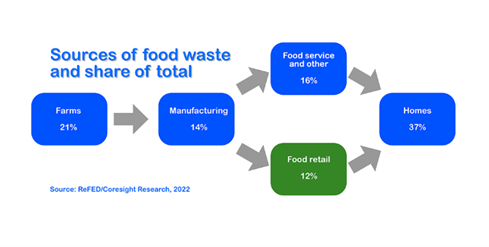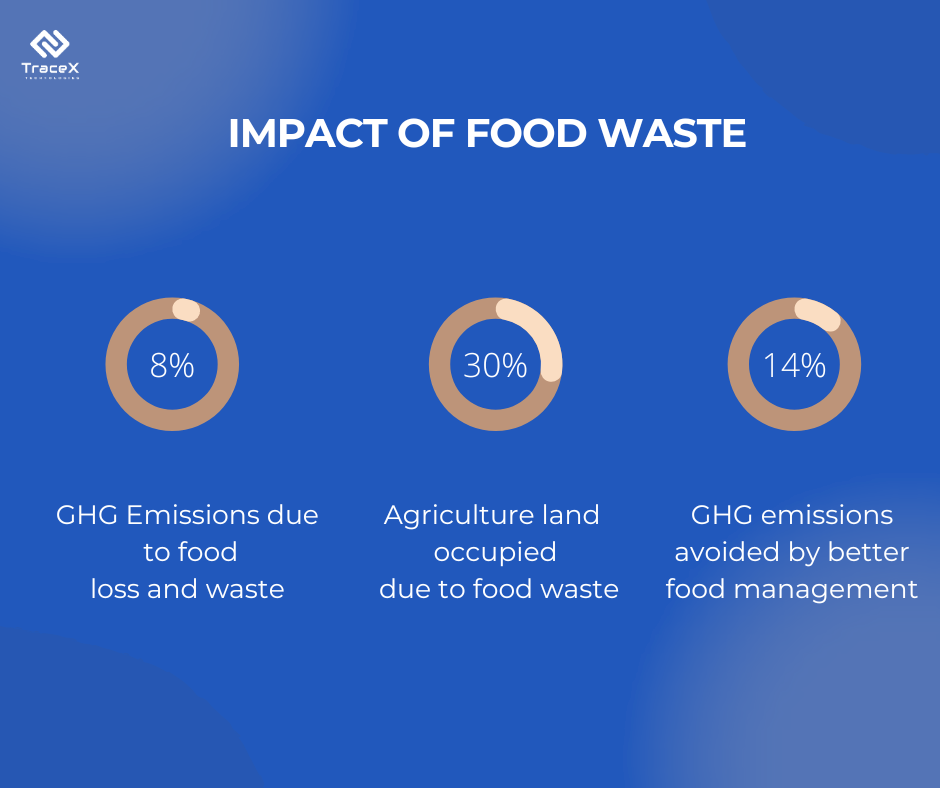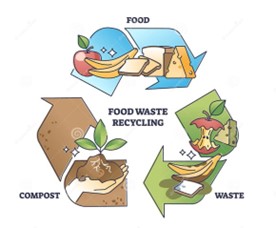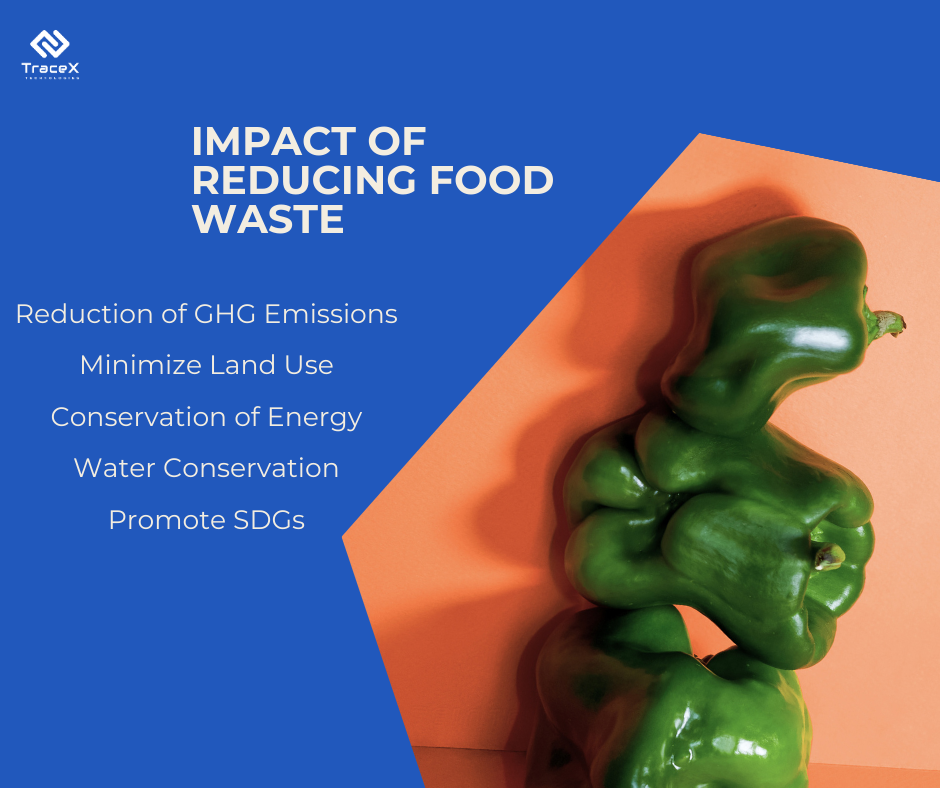Contact: +91 99725 24322 |
Menu
Menu
Quick summary: Discover the significant impact of food waste on climate change and explore the interconnectedness between these two pressing global issues. Learn about the environmental consequences of food waste and how it contributes to greenhouse gas emissions. Find out how reducing food waste can mitigate the effects of climate change and create a more sustainable future.

Did you know that every year, millions of tons of food are wasted along the supply chain, from farm to fork? It’s a shocking reality that not only impacts our environment but also contributes to global hunger and economic losses. Discover the hidden truth behind food waste in supply chains. Food waste is a global challenge that affects not only our environment but also our economy and social well-being. Within the complex web of food production, distribution, and consumption, supply chains play a crucial role in determining how much food is lost or wasted.
According to McKinsey, 33% to 40% of the world’s food is lost or wasted every year, yet one in nine of the world’s population can’t get enough to eat—that’s equivalent to 800 million suffering from hunger.
At every stage of the food chain, from production to consumption, food waste is a serious problem. Harvest, storage, processing, sale, and consumption are all parts of the supply chain where food that is still edible may be disposed of.

Food waste is a silent epidemic that lurks at every turn of the supply chain, stealthily siphoning off precious resources and contributing to environmental degradation. At the production stage, farms witness the heartbreaking sight of imperfect produce being cast aside, surplus crops left to rot, and post-harvest losses silently eroding hard-earned yields. Processing facilities, despite their best efforts, witness inefficiencies during processing and packaging, leading to the heartbreaking sight of perfectly edible food ending up in the waste bin. During distribution, the journey from farm to fork becomes a perilous one, with transportation woes, storage mishaps, and mishandling culminating in the untimely demise of food items. Even in the hallowed halls of retail, where shelves groan under the weight of abundance, overstocking, stringent expiration dates, and the tyranny of cosmetic standards conspire to sentence perfectly good food to an ignominious fate. And alas, at the final frontier of consumption, where food meets its intended destiny, consumers grapple with confusion over labels, succumb to the whims of impulse purchases, and fall prey to the scourge of lacklustre meal planning, unwittingly contributing to the ever-swelling tide of waste. From farm to fork, each stage of the supply chain bears witness to the tragic saga of food waste, underscoring the urgent need for concerted action to stem the tide and build a more sustainable food system for generations to come.
Agriculture and food supply chain disruptions can have great impacts on food security, economic stability and social well-being.
Uncover the critical factors shaping agriculture and food supply chains!
Food waste and food loss are related concepts but have distinct meanings:
Food Loss:
Food Waste:
In summary, food loss occurs primarily during the early stages of the supply chain before food reaches consumers, while food waste occurs at various stages of the supply chain and includes food discarded by consumers and food establishments.
In India, 67 million tonnes of food are wasted and about 70-75% of food waste rots in landfills.
Food waste is a problem that has big environmental effects. When food is wasted, the resources of land, water, energy, and labour used to generate it are also lost. Due to this, water use, deforestation, and greenhouse gas emissions rise unnecessarily, all of which contribute to climate change and biodiversity loss.
“Food waste is an ethical outrage”, stated UN’s Secretary-General, António Guterres on UN’s designated International Day for the Awareness of Food Waste and Loss
The connection between food waste and global warming lies in the significant amount of greenhouse gas emissions produced throughout the food supply chain, from production and distribution to consumption and disposal. When food goes to waste, all the resources used in its production such as water, energy and land are also wasted along with th e emissions generated. Global warming is significantly exacerbated by food waste. When food is wasted, it ends up in landfills where it decomposes and generates methane, a powerful greenhouse gas that has a 25-fold greater effect on global warming than carbon dioxide.
According to the UN, after China and the United States, food waste would be the third-largest producer of greenhouse gases if it were a nation.

The environmental impact of food waste is significant and multifaceted:
– When food waste is sent to landfills, it decomposes anaerobically, releasing methane, a potent greenhouse gas that contributes to climate change.
– Methane has a much higher global warming potential than carbon dioxide, making it a significant contributor to climate change.
The food industry is responsible for 8-10% of the total Greenhouse gas emissions.
– Food production requires vast amounts of resources such as water, land, energy, and nutrients. When food is wasted, these resources are also wasted, leading to inefficient resource allocation and depletion.
– For example, agriculture accounts for a large portion of freshwater usage globally, and wasted food represents a loss of water resources used in its production.
– Agricultural expansion for food production can lead to habitat destruction and biodiversity loss, as natural ecosystems are converted into farmland.
– When food is wasted, it not only represents a loss of resources but also contributes to the demand for more agricultural land, exacerbating the pressure on natural habitats.
– Food production, processing, transportation, and storage require significant energy inputs. When food is wasted, the energy invested in its production and distribution is also wasted, leading to unnecessary energy consumption and associated environmental impacts.
– Food waste disposed of in landfills contributes to landfill pollution, including leachate runoff and soil and water contamination. These pollutants can have adverse effects on ecosystems and human health.
Overall, addressing food waste is essential for mitigating its environmental impact and promoting sustainability across the food system. Reducing food waste can help conserve resources, reduce greenhouse gas emissions, protect biodiversity, and minimize pollution.
The economic and social impacts of food waste are profound:
– Food waste represents a significant economic loss throughout the supply chain, from production to consumption.
– Farmers incur losses due to wasted inputs such as labor, water, and fertilizers, as well as unsold or discarded crops.
– Food manufacturers and retailers lose revenue on unsold products, and additional costs are incurred for waste disposal.
– Consumers waste money on purchased food that is ultimately thrown away, contributing to household expenses.
– Food waste leads to increased costs for waste management, transportation, and landfill disposal.
– Businesses incur expenses associated with handling, storing, and disposing of wasted food, impacting their profitability.
– Municipalities and governments bear the costs of waste collection and disposal, diverting resources from other essential services.
– While food is wasted at various stages of the supply chain, millions of people worldwide suffer from food insecurity and hunger.
– The resources wasted on food production and distribution could have been redirected to alleviate hunger and improve food access for vulnerable populations.
– The environmental impacts of food waste, such as greenhouse gas emissions and resource depletion, also have economic consequences.
– Environmental degradation can lead to reduced agricultural productivity, increased production costs, and disruptions to supply chains, affecting livelihoods and economic stability.
– Food waste exacerbates social inequalities by perpetuating disparities in access to food and resources.
– Vulnerable communities, including low-income households and marginalized groups, are disproportionately affected by food insecurity, while excess food is wasted elsewhere.
Overall, addressing food waste is crucial for promoting economic prosperity, social equity, and environmental sustainability. By reducing waste and improving resource efficiency, societies can create more resilient and equitable food systems for all.
Reducing food waste is imperative for companies aiming to achieve sustainability objectives, as it not only supports environmental goals but also contributes to social targets. SDG 12.3, for instance, urges a reduction in food waste by half by 2030, aligning with broader aims such as SDG 2, Zero Hunger. Many major food corporations, including Nestlé, have committed to reducing food waste as a core sustainability objective, achieving significant milestones in waste reduction.
In response to the climate crisis, sustainability goals have become essential for businesses, with stricter regulations emerging globally. The EU, for example, has implemented binding targets to reduce food waste, while Sweden has set ambitious strategies for halving food waste by 2030.
Crucial to achieving these objectives is the ability to measure progress accurately using quality data. Sustainability management solutions play a key role in this regard, enabling companies to monitor their sustainability efforts and align with frameworks such as the SDGs effectively.


Coresight’s survey found that 84% of respondents plan to invest in technology to manage food waste.
Innovations in food packaging and preservation:
Digital solutions for reducing food waste- Blockchain traceability for supply chain management:
Digital solutions, particularly blockchain traceability, offer promising avenues for reducing food waste throughout the supply chain. By leveraging blockchain technology, stakeholders can enhance transparency, efficiency, and accountability in food production, distribution, and consumption processes. Blockchain enables real-time tracking of food products from farm to fork, allowing for precise identification of inefficiencies, bottlenecks, and areas of waste. Through immutable, transparent records, blockchain traceability provides stakeholders with actionable insights into factors contributing to food waste, such as spoilage, transportation delays, and overproduction. With greater visibility and data-driven decision-making, businesses can optimize inventory management, streamline logistics, and minimize food losses. Additionally, blockchain facilitates collaboration among supply chain partners, fostering trust and coordination to prevent waste at every stage. As a result, digital solutions like blockchain traceability hold immense potential to revolutionize food supply chains, promote sustainability, and mitigate the impacts of food waste on economies, societies, and the environment.
TraceX blockchain traceability solutions address supply chain food waste challenges by providing transparency, accountability, and efficiency throughout the entire food production and distribution process. Here’s how:
1. Real-time Monitoring: TraceX enables real-time monitoring of food products as they move through the supply chain. This visibility helps identify potential bottlenecks, delays, or issues that could lead to food waste.
2. Data-driven Decision-making: By leveraging blockchain technology, TraceX collects and analyzes data at every stage of the supply chain. This data provides valuable insights into factors contributing to food waste, allowing stakeholders to make informed decisions to optimize processes and minimize waste.
3. Traceability and Recall Management: With TraceX, every food product is assigned a unique digital identity that is recorded on the blockchain. This ensures complete traceability, making it easier to track the origin of products in case of contamination or recalls, thereby reducing the volume of wasted food due to safety concerns.
4. Inventory Management: TraceX helps streamline inventory management by providing accurate and up-to-date information about the quantity, location, and condition of food products in the supply chain. The FIFO and FEFO features prevents overstocking, reduces the risk of spoilage, and ensures that food items are utilized efficiently.
5. Collaboration and Transparency: TraceX promotes collaboration and transparency among supply chain partners by providing a shared platform where data can be securely accessed and verified. This fosters trust and accountability, leading to better coordination and communication to prevent food waste.
Overall, TraceX blockchain traceability solutions empower stakeholders in the food supply chain to proactively identify and address food waste challenges, ultimately leading to a more sustainable and efficient food system.
In conclusion, addressing food waste in supply chains is a multifaceted challenge that requires collaborative efforts and innovative solutions from all stakeholders involved. By raising awareness about the scale of the problem, implementing sustainable practices, adopting technology-driven solutions like TraceX, and fostering a culture of responsibility and accountability, we can make significant strides towards reducing food waste and building a more sustainable food system. Together, let’s work towards minimizing waste at every stage of the supply chain and ensuring that food reaches those in need while preserving our precious resources for future generations.
